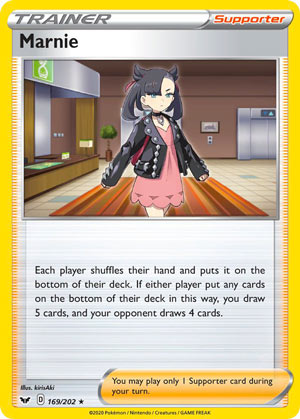
Marnie
– Sword & Shield
Date Reviewed:
February 20, 2020
Ratings Summary:
Standard: 4.67
Expanded: 4.50
Limited: 5.00
Ratings are based on a 1 to 5 scale. 1 is horrible. 3 is average. 5 is great.
Reviews Below:
 Otaku Marnie (Sword & Shield 169/202, 200/202, 208/202) is our 2nd-place pick. This new Supporter has an easy to misread effect. Marnie has each player shuffle the contents of their hands, then place those cards on the bottoms of their respective decks. So long as at least one of you bottom-decked cards through this effect, the player who used Marnie draws five cards, while their opponent draws four cards. Please note that neither player shuffles their hand into their decks, and at least one of you had to bottom deck at least one card in order for you both to draw. I’m not sure if you can even play Marnie if both players’ hands are empty, but you can use it if at least one player bottom decks one card. In general, a four card hand is poor (but not terrible), and a five card hand is good (but not great). You can get an idea of this by looking and recent and semi-recent cards. Judge was sometimes good, sometimes not, and it forced both players to shuffle their hands away and then draw four cards (plus it eventually gained Judge Whistle). Marnie’s effect can help or hurt either player, and in the same ways. Someone may be forced to bottom deck some useful cards or some clutter, and may draw a better, worse, or equivalent hand (in terms of quality, if not size). Marnie doesn’t have any specific support to go with her card, but her effect is lopsided in your favor, and controlling when it gets played is how you can skew those results to your favor. That can be as simple as just thinning your hand before you play Marnie, so that the only things you bottom deck are stuff you don’t want to see or stuff you wouldn’t want to have to discard with Professor’s Research. Or using it the turn after your opponent telegraphed an important card was in their hand. It can be as complex as adding in combos; after all, your opponent now only has four cards in hand to further whittle down. In the successful Japanese lists I’ve seen so far – and that isn’t many, I’m afraid – most decks are going to run Marnie. Not all, though, and the count can vary from a single clutch copy to a full four count. The only new Trainers run more abundantly were yesterday’s and tomorrow’s cards! Being good draw plus good disruption makes Marnie a great card for the Standard Format, and pretty good for Expanded as well. Arguably, Marnie may be even better in Expanded; even with so many banned, there will still be hand disruption – if not outright control – combos available. Marnie does face some famous competition here, because N does something very similar in the role it fills. Perhaps, though, the two can share, even though deck space is so tight. Marnie is a must run if you pull her in the Limited Format. I realize that is a lot like saying “Water is wet.” to anyone with even a little Pre-Release experience; you’re just not going to have as many Supporters as you’d like here, even taking into account your deck is 40 cards (instead of 60). Ratings
Yes, another series of perfect scores for all three major Formats… but, don’t think that means Marnie is actually a perfect card. I mentioned it yesterday; since I’ve simplified my scoring process, a five-out-of-five can be just a really great card as opposed to something bordering on broken. Though, if the new T1 rules aren’t enough to curb potent hand control combos, Marnie could lead to something a little too good. I had Marnie as my 3rd-place pick but as you can tell by the scores, she easily could have – and perhaps should have been – at least my 2nd-place, perhaps even my first. |
 Vince Marnie Ratings:
Details: I don’t know what to think of about her because I did not play Sword & Shield. But for the TCG version of her, one thing is made clear: she’s the second best card of the set. When you get to see what she does, you might understand why. So she does things similar to what N does. Both involve putting away both players’ current hand and both of them draw cards. While N makes both shuffle their hand into their deck, Marnie makes both players shuffle their hand and put them at the bottom of their decks. Unlike N, who makes both players draw cards based on how many prizes remaining, Marnie guarantees you five cards while it guarantees the opponent four cards. Just like N, it’s usefulness depends on a variety of situations. You might have a bad hand and wanted to refresh your hand with five new cards. Your opponent might have a good hand, and Marnie suddenly ruins your opponent’s hand (yeah, that happened to me several times before)! The opponent might say the same thing against you, and she could be your downfall as well. |
 aroramage Ahhh yes, nothing should be surprising about one of your rival characters becoming a Supporter card. If anything, it might be more surprising that they ended up on our list, especially this high up on it. Considering most rival characters end up on some kind of “draw 3” card, it’s nice to see them change it up a bit. Marnie is a Supporter that shuffles both players’ hands before putting them at the bottom of the deck, and if either player put cards back, then both sides get to draw some cards – you get 5 cards while your opponent gets 4 cards. This puts Marnie in a similar category of sorts to something like N or Judge, Unlike those two, though, she does have her own advantages. First off, comparing with Judge, Marnie has a lot of similarities – both put cards back into each deck, and both have both players draw a set number of cards. But the differences are key here; Marnie will put the cards back at the bottom of the deck, meaning that – duplicates aside – you’re not going to draw the same cards in your brand new hand of 5! And you’re also getting the advantage of having an extra card over your opponent, something Judge doesn’t work hard enough at to do. Similar to N or Judge, Marnie can be used when your opponent has a lot of cards in hand to trim down on, but while N could potentially get them down in the late game to having 1 or 2 cards, Marnie still gives them 4 cards. However, N also didn’t have to worry about the probability of drawing a similar hand, since you could manipulate the hand size. Marnie does worry about that, but she guarantees that those cards will be at the bottom – which is crucial if, say, your opponent were to add cards to their hand that they didn’t play. It’s a lot more effort to get the same card twice, after all! Naturally, I think Marnie will feature prominently in lots of decks, partly for disruption and partly for the advantage she can a player through her effect. Definitely keep an eye out for her over the coming weeks! Rating Standard: 4.5/5 (absolutely a big card to run in many decks) Expanded: 4.5/5 (arguably on the same level as N, though N is better in the late game) Limited: 5/5 (draw power and disruption is draw power) Arora Notealus: It should come as no surprise that the top 2 cards are Supporters, or that the top 5 cards ended up as Trainer cards. When you’ve got stuff like Marnie jumping in and defining what it means to be a good card in Standard, it’s bound to have some effect on the game. Now it’s just a matter of competing with other Supporters, and there sure are a lot, but I think Marnie will find her place easily enough. Next Time: And the #1 card of the set shouldn’t even be a surprise at this point. |
We would love more volunteers to help us with our Card of the Day reviews. If you want to share your ideas on cards with other fans, feel free to drop us an email. We’d be happy to link back to your blog / YouTube Channel / etc. 😉
Click here to read our Pokémon Card of the Day Archive. We have reviewed more than 3500 Pokemon cards over the last 17+ years!



